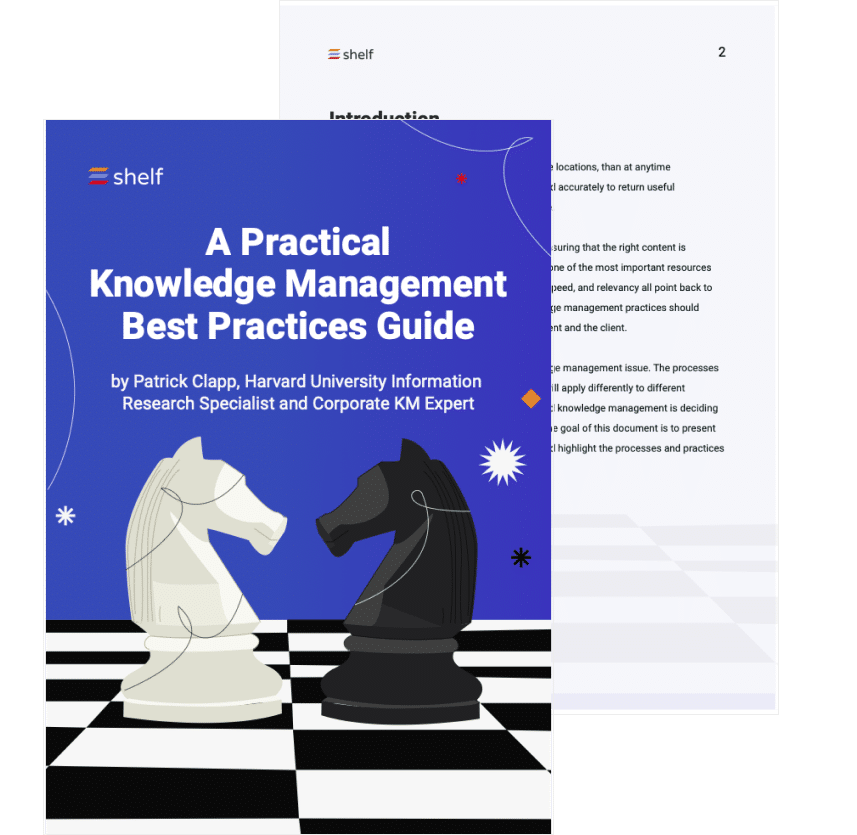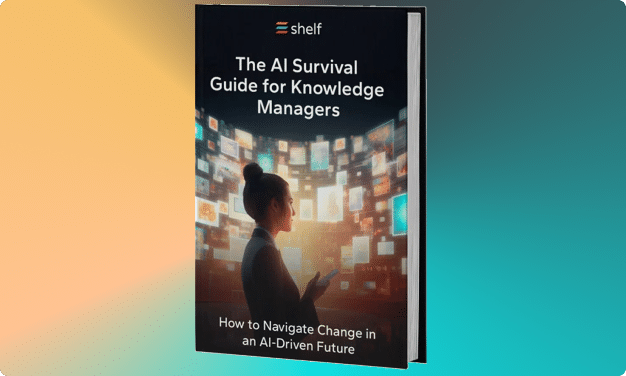Implementing a knowledge management system or exploring your knowledge strategy? Before you begin, it’s vital to understand the different types of knowledge so you can plan to capture it, manage it, and ultimately share this valuable information with others.
Populating any type of knowledge base requires you have a process in place to capture knowledge; you need a documented KM system that defines how people, processes, and technology will work together to achieve a goal.
In this post, we’ll define the different types of knowledge, give a few practical examples to illustrate, and explain why each type matters.
1. Explicit knowledge
Explicit knowledge is the easiest type to incorporate into your knowledge base.
What is explicit knowledge?
Explicit knowledge is any knowledge that is easy to express, document, codify, and share. Much of the knowledge you’ll be handling is explicit knowledge. You can easily verify if explicit knowledge is true or false.
It’s structured knowledge often expressed in formulas, data, and manuals. Explicit knowledge can be transmitted with no loss of accuracy if everyone understands the systems and rules for decoding it.
Practical examples of explicit knowledge
You’ll find explicit knowledge in textbooks, encyclopedias, documents, and manuals. The building code your general contractor followed to build your house is explicit knowledge, as are the geometry formulas the architect used to draw up plans.
Some examples of explicit knowledge in the workplace include:
- Employee onboarding procedures
- Employee training videos and manuals
- Product tutorials
- Market research
- Financial information
- Software documentation
Why explicit knowledge matters
Explicit knowledge encompasses all of the procedures and activities related to the daily business operations of your organization.
Your business will run more efficiently and effectively if you have systems to easily transmit explicit knowledge. Explicit knowledge lets you standardize practices and procedures to achieve repeatable, high-quality results in all of your systems.
Read these proven tips to manage all types of knowledge
Get this essential guide to knowledge management best practices from Harvard expert Patrick Clapp.
2. Implicit knowledge
Implicit knowledge draws upon the lived experiences of your employees.
What is implicit knowledge?
Implicit knowledge is gained through real-life experience or hands-on applications. It’s what happens when you apply explicit knowledge to a specific situation. Although implicit knowledge is more difficult to transmit than explicit knowledge, it’s still extremely valuable to your company. It includes the experiences of the people in the trenches doing the work.
Anyone who’s tried to learn anything can attest that hearing from someone who has done it before can make the process much easier. Explicit knowledge is reading the manual on how to build a boat. Implicit knowledge is meeting with other boat builders who can give you guidance and recommendations.
Practical examples of implicit knowledge
Your team members will build up a store of implicit knowledge over the years. When someone skillfully and quickly performs a task, they undoubtedly have implicit knowledge about it. If a newbie comes along and tries to perform the same task, it will take them longer, and their results won’t be as impressive.
For example, you can read a book about pottery that may walk you step by step through turning a bowl on a pottery wheel. However, your first attempt probably won’t look professional. After you gain implicit knowledge from working with pottery for years, you’ll know exactly how much pressure to apply and where and the signs that something may go wrong.
Why implicit knowledge matters
Implicit knowledge bridges the gap between practical and experiential knowledge. Capturing the implicit knowledge of your workforce can help prevent new employees from making expensive mistakes and save them hours of labor.
While you might normally pair a mentor with a junior employee, capturing implicit knowledge in your knowledge management system will allow you to pass on the experience of your top performers to all of your employees. You can also capture the implicit knowledge of employees before they retire or leave your company and take all of their experience with them.
3. Tacit knowledge
Tacit knowledge is often confused with implicit knowledge because they’re both gained from experience. However, there are some important differences.
What is tacit knowledge?
Tacit knowledge is the knowledge you’ve gained through experience but is difficult to express clearly to someone else. You may not even realize you have tacit knowledge. If someone asks you how you do something so well, and you respond, “I don’t know. I just do it,” it’s probably tacit knowledge.
Tacit knowledge isn’t impossible to capture and add to your knowledge base, but it will take effort and time, often involving the one-on-one transfer of knowledge to start.
Practical examples of tacit knowledge
You can find people in your organization with excellent tacit knowledge by thinking of employees who seem to have a natural talent at whatever they do. It may be a salesperson who seems to intuitively know when to make a pitch or an IT team member who can find and fix a tech problem faster than anyone else can.
Why tacit knowledge matters
Tacit knowledge can be the difference between an employee who performs at a high level and one who barely accomplishes the minimum requirements. As you build procedures for documenting tacit knowledge, it will be easier to include it in your knowledge base.
When you’re starting to capture tacit knowledge, it can help to have a third-party help capture and process tacit knowledge for later use.
4. Declarative knowledge
Declarative knowledge is explicit knowledge that can be easily stored in a database, like a knowledge management platform.
What is declarative knowledge?
Declarative knowledge is “knowing what.” It includes static information, such as the facts and figures related to a topic. Unlike tacit knowledge, people are very aware when they have declarative knowledge. Declarative knowledge includes the subject’s principles, elements, details, classifications, and more.
When you onboard a new employee, you expect them to learn a certain amount of declarative knowledge about your products and procedures.
Practical examples of declarative knowledge
All of the facts you learned in school were declarative knowledge. This includes, for example, the classification of living things, the pharaohs of ancient Egypt, and the elements of classical tragedies. In your business, declarative knowledge might include the characteristics of the products you sell or who is responsible for what duties.
Why declarative knowledge matters
Declarative knowledge is often the knowledge you want your employees to commit to memory. If you own a restaurant, you want your servers to know the ingredients in all of your entrees. If you sell copiers, you want your salespeople to know the features and benefits of each model.
Understanding declarative knowledge will help your employees more easily perform their job duties. Your knowledge manager should work with the leaders in your organization to identify the declarative knowledge that’s important for each role and incorporate that into onboarding training.
5. Procedural knowledge
Procedural knowledge is an expressive form of implicit knowledge.
What is procedural knowledge?
Whereas declarative knowledge is concerned with who and what, procedural knowledge is concerned with how. Procedural knowledge is the knowledge you use to perform a task step-by-step. It’s gained from experience.
Practical examples of procedural knowledge
Knowing how to drive a car is an example of procedural knowledge. No matter how often you read the driver’s manual, you won’t know how to drive until you do it. Once you can easily drive a car, you’ve gained procedural knowledge regarding driving. In business, procedural knowledge might include knowing how to pick and pack inventory at a warehouse.
Training might give you the explicit and implicit knowledge to understand what to do, but you can’t internalize the procedural knowledge until you’ve spent several shifts on the floor.
Why procedural knowledge matters
Employees will rely on procedural knowledge to do the routine parts of their jobs. Procedural knowledge is particularly important for roles that require following step-by-step directions. Procedural knowledge won’t be documented in your knowledge management system, but the explicit and implicit knowledge that’s a precursor to it will be.
6. Conditional knowledge
Conditional knowledge is a type of knowledge that synthesizes declarative and procedural knowledge.
What is conditional knowledge?
Conditional knowledge is knowing when and why to use declarative and procedural knowledge. You need critical thinking and problem-solving strategies to use conditional knowledge organically. However, a type of conditional knowledge is used in decision trees, which can be documented in your knowledge management system.
Practical examples of conditional knowledge
A decision tree is an example of conditional knowledge type. It doesn’t do your thinking for you but gives you a tool to standardize decision-making for the best results.
Decision trees help map a series of questions, decisions, and potential outcomes. They can be used to guide customer service agents through the process of handling complex cases.
Why conditional knowledge matters
Conditional knowledge is important in determining when to use your accumulated knowledge. Your workforce won’t get much use out of your knowledge management system if they don’t know what knowledge they need to use and when.
7. A priori knowledge
A priori knowledge is a philosophical concept that comes from Latin and means “from the former”.
What is a priori knowledge?
A priori knowledge is knowledge that can be gained without experience. If you can know something is true just from reading it, it’s a priori knowledge. You can determine its validity if you understand the words and concepts in a piece of a priori knowledge
Practical examples of a priori knowledge
A statement like “Triangles have three sides” exemplifies a priori knowledge. You don’t need to personally experience triangles to know this is true. It’s true because the definition of a triangle is a shape with three sides.
Why a priori knowledge matters
A priori knowledge is important in many different fields. You’ll undoubtedly have many types of a priori knowledge in your knowledge base that your employees will use in their roles.
You can use a priori knowledge to help predict business processes and plan for future projects since it’s not dependent on experience.
8. A posteriori knowledge
A posteriori knowledge is a knowledge that comes from experience. It’s similar to implicit knowledge in this aspect.
What is a posteriori knowledge?
A posteriori knowledge is knowledge you gain from first-hand experience or others’ experience. Debriefs and “post-mortems” in the workplace help garner this knowledge.
Practical examples of a posteriori knowledge
You can use a debrief after a major project completes to gather experiences and lessons learned from employees who participated. This knowledge can be analyzed to garner new policies and practices for the next project. It can help you adapt not only processes, but every piece of a posteriori knowledge helps contribute to the redesign and engineering of new products and services.
Why a posteriori knowledge matters
A posteriori knowledge is valuable in business because it allows you to codify your experiences as well as the experiences of others into your knowledge base. This is a valuable type of knowledge that could otherwise be lost when employees leave your company.
9. Contextual knowledge
Contextual knowledge is acquired knowledge that can vary depending on circumstances.
What is contextual knowledge?
Contextual knowledge is only relevant in a specific situation. It’s the context, skills, or information needed in particular circumstances.
Practical examples of contextual knowledge
Contextual knowledge might include the social, emotional, cultural, or economic environment in which knowledge is needed or created. For example, looking someone in the eye shows integrity and respect in America. However, in Japan, extended eye contact is considered rude and disrespectful.
Why is contextual knowledge important?
In your knowledge management database, providing context for user requests can help specify the meaning of the request and return more accurate results.
How to capture and process knowledge types
To capture and distribute all types of knowledge, you need a well-documented knowledge management system that includes modern KM technology. There are many knowledge management tools on the market, but not all can easily store and distribute knowledge in consumable content types people prefer like FAQs, decision trees, or wikis.
Knowledge capture is the first step in a knowledge sharing culture; no matter what KM solution you use, you should always make knowledge usable to employees, contact center agents, or customers.
In this future, knowledge management software must process a growing amount of knowledge-related data to keep answers up-to-date and usable—and these solutions must use automation to pull it off.
Instead of following KM best practices that were relevant 10 years ago, get our latest knowledge management best practices guide to help you navigate the current KM landscape.
Read this Next
A Practical Knowledge Management Best Practices Guide
Applying outdated knowledge management best practices? Here’s what knowledge managers need to know in a modern enterprise environment.





